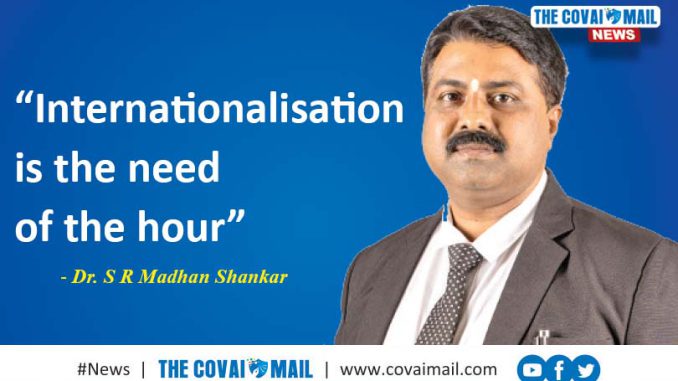
– Dr. S R Madhan Shankar

The most important aspect in a student’s education is the opportunities that they get to gain a world’s view understanding of their subjects. To know and learn beyond the textbook makes every learner to be more equipped to take on challenges. Dr. S R Madhan Shankar had a vision of bringing to his students a different perspective on their subjects from professors abroad. That is why he worked to sign an MoU with the Faculty of Agricultural Technology, Universitas Brawijaya, Indonesia. He is currently in the country, as part of a teaching exchange and mobility program, and on video call interview shares with us the reasons why he wanted to sign this MoU and how it came about along with his future plans.
Why did you choose Universitas Brawijaya amongst all the universities outside of India?
The way I picked Brawijaya University was because I previously knew Professor Teti Estiasih of the Faculty of Agricultural Technology. We were in touch for some time, probably 2 to 3 years and We have been trying to work on certain projects related to food processing and food biotechnology. In 2020, when conversing, we accidently came out with a concept: why don’t we have a formal collaboration for teaching and research. During the time of my joining Kongunadu Arts and Science College- My Alma mater , the vision statement that I gave to my department was internationalization by 2025. We were lucky that Brawijaya also had a similar vision statement ie. by 2020-21 to implement outcome based education and internationalization by 2025. So we took it as an opportunity to sign the MoU
What was the process like?
Initially, we had a long discussion for about 6 months from April of 2020 to September to come up with the best way for this exchange because the kind of teaching pedagogy and the structure which is seen in Brawijaya is slightly different from Kongunadu. We wanted to understand how we can blend the structures together. We were then finally able to narrow down on signing an MoU in the month of November 2020, in the midst of the covid pandemic, knowing very well that we will not be able to go for the physical exchange program. After the MoU was signed we again had discussions for another 6 months, from November till March or April, for us to match the academic curriculum available in this department. We were very lucky that at least in every semester two or three courses where matching for us like both sides had the same course content. From April 2021 onwards, we started learning to understand how we can engage in a joint teaching program for our undergraduate students as well as their undergraduate students. This again took 4 months to materialize and in September, 2021 we gave the first class on online mode. I taught the students of Brawijaya four sessions on Cell Biology and Molecular Biology. We got very excellent feedback from the students and subsequently in the month of October and November, professors from Brawijaya taught our students. This trend followed in 2022 as well. Three more faculty from my deparement Dr Dinesh Kumar, Dr Aravindganth and Dr S Bhargavi taught students of Brawijaya in the online mode. Later, since the restrictions were relaxed, we decided to do a physical exchange program and hence I am here in Indonesia.
What are your plans like for your stay there?
So what I am doing is for the first two weeks I have been holding meetings with several departments and different schools of Agriculture Science, School of Biotechnology, Food Processing and Computer Science on how we can further collaborate and expand this program. I will also be handling 22 sessions of classes for various students here for about one and half hours each day on various topics including Bioinformatics, Computational biology, Biology of cell, Entrepreneurship, Industrial Microbiology and Engineering. This is the road map for my stay for the next 30 to 38 days.
Now that you’ve stayed there for a while, how would you see the college experience here in India and here and there in Indonesia? Are there any differences or similarities?
I would say similarities first. The kind of courses they offer, the core structure they have and the way they have organized their theory and practical classes is almost the same between both institutions. But differences, I would say, is how these people perceive an industrial connection and an innovation in day-to-day teaching learning activities as a very important factor. The second difference which I feel is that students have lots of options for self learning. It’s not like our regular classes where they go and sit in a class for six hours and they are taught. Here the library is flooded with students. When I went to the library, it was full with students. There are common areas where students have Wi-Fi and they work from the computers in those areas. So everywhere you can see students sitting and participating in the regular teaching learning process. This is something missing in our set up of a participatory learning using novel pedagogies .
What is your wish for the students to take away from this program?
Internationalization is the need of the hour and as we are becoming a global village everybody wants internationalization not just for saying “See I’m going to this country I’m learning this.” It is not just to understand science and technology, it’s also to understand their culture, their tradition and how we are close to each other in those terms. I had an on-air session just before now. I was really interested to understand that most of what they have in Indonesia, we also have back home. For example, most of these people understand Sanskrit because the numbering systems are the same. We also have similar words from Indodesian in both Hindi and Tamil. So exchange programmes are not just meant for somebody to do only teaching or only research. It’s also to explore
What are your future plans for this program?
When I’m coming back on March 10, we have 3 professors from this institution who are coming to Kongunadu Arts and Science College. They’re going to stay with us and teach our students for about 22-23 days. They are also going to be a part of our board of studies. This is to ensure that flavours in the curriculum from Brawijaya will get translated into my department and we will have a much better sale for choosing the best curriculum to continue this program. We are also extending our exchange programmes to Edinburgh Napier University, University of Westminster in London shortly after this visit of mine.
